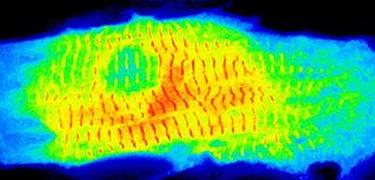
Professor Manuela Zaccolo
Professor Zaccolo graduated in medicine from the University of Torino, Italy, and subsequently spent four years as a post-doctoral researcher at the LMB, MRC, Cambridge, UK, working on protein engineering and in vitro molecular evolution. She then moved back to Italy, to the University of Padova, to work on the generation of fluorescent sensors for real time imaging of intracellular second messengers in living cells. In Padova, she established her independent research group in 2001 at the Venetian Institute of Molecular Medicine, with a focus on intracellular signalling. In 2007 she moved to the University of Glasgow, where she initially held a position as a Reader and subsequently as Professor of Cell Biology. In 2012 she joined the Department of Physiology, Anatomy and Genetics at University of Oxford.

AKAP-dependent localisation of a FRET reporter for cAMP in a cardiac myocyte (Zaccolo Research Group)
Professor Zaccolo's research focuses on how cells sense external stimuli and how these are processed to produce a functional outcome. She is interested in the architectural and regulatory principles by which intracellular signalling networks achieve the plasticity and context-sensitivity necessary for a cell to function. In particular, her work has focused on cyclic nucleotide signalling in the heart and on the role of local regulation and compartmentalisation of signal transduction in determining the specificity of cellular responses. Her ultimate goal is to understand how alteration of signalling networks leads to human disease and to apply this knowledge to the development of novel therapeutic strategies.
Further information can be found at Zaccolo Research Group.

 Our mission: To reduce the burden of cardiovascular disease.
Our mission: To reduce the burden of cardiovascular disease.